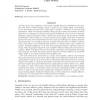Free Online Productivity Tools
i2Speak
i2Symbol
i2OCR
iTex2Img
iWeb2Print
iWeb2Shot
i2Type
iPdf2Split
iPdf2Merge
i2Bopomofo
i2Arabic
i2Style
i2Image
i2PDF
iLatex2Rtf
Sci2ools
160
Voted
JMLR
2011
2011
Robust Statistics for Describing Causality in Multivariate Time Series
A widely agreed upon definition of time series causality inference, established in the seminal 1969 article of Clive Granger (1969), is based on the relative ability of the history of one time series to predict the current state of another, conditional on all other past information. While the Granger Causality (GC) principle remains uncontested, its literal application is challenged by practical and physical limitations of the process of discretely sampling continuous dynamic systems. Advances in methodology for time-series causality subsequently evolved mainly in econometrics and brain imaging: while each domain has specific data and noise characteristics the basic aims and challenges are similar. Dynamic interactions may occur at higher temporal or spatial resolution than our ability to measure them, which leads to the potentially false inference of causation where only correlation is present. Causality assignment can be seen as the principled partition of spectral coherence among i...
Related Content
| Added | 14 May 2011 |
| Updated | 14 May 2011 |
| Type | Journal |
| Year | 2011 |
| Where | JMLR |
| Authors | Florin Popescu |
Comments (0)

